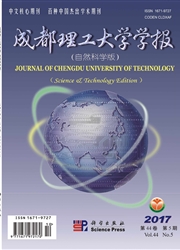

 中文摘要:
中文摘要:
重庆地区早三叠世沉积中广泛发育一种“错时相”灰岩——蠕虫状灰岩。通过对重庆地区十余条典型剖面飞仙关组及嘉陵江组进行野外观察、采样及室内薄片鉴定、扫描电镜研究,认为蠕虫状灰岩由形似蠕虫的“蠕体”和浅色基质组成,其中蠕体形态多样,常呈条带状、粒状、不规则状发育于基质中,蠕体的主要成分为方解石(质量分数高达95%以上),基质中相对含有较多黏土,但方解石的质量分数依然可达到85%~90%。蠕虫状灰岩中几乎见不到大的生物化石,镜下可观察到黄铁矿颗粒及藻类痕迹。按形态可将蠕虫状灰岩分为顺层线纹状、断续点状和异形杂乱状3类,其形成主要和菌藻类活动有关,并且在其形成过程中风暴作用影响明显,后生动物(如腕足、腹足及双壳类)的扰动会抑制蠕虫状灰岩的发育,因此蠕虫状灰岩的成因是(低等)生物与水动力共同作用的结果。二叠纪末-三叠纪初特提斯洋海水温度高,大气 CO2含量极高而 O2含量却极低,相应的古海洋是停滞的、缺氧的并且伴随有频繁的风暴,这些都为蠕虫状灰岩的形成提供了条件。
 英文摘要:
英文摘要:
The vermicular limestone is one of the anachronistic limestone and widespread in the Lower Triassic Feixianguan Formation and Jialingjiang Formation in the Chongqing area.In terms of detailed field observation,sampling,thin-section identification,SEM,etc.for more than 10 sections,it is considered that the vermicular limestone consists of dark vermicuform bodies and light-coloured tint matrixes,among which the vermicuform bodies are in varied shapes.The main composition of the vermicuform bodies is calcite,whose content is above 95%.The matrix has more clay content,whose calcite unexpectedly reaches 85% ~ 90%.There are few metazoan fossils that can be found in vermicular limestone,but pyrite and algae are observed under the microscope.According to the shape,the vermicular limestone is divided into three types,that is,laminar-like limestone,spot-like limestone and messy-like vermicular limestone.The formation of the vermicular limestone is related to cyanobacteria or algae activities,and the storms play a very important role in the process of its formation.The disturbance of metazoans (e.g.brachiopods,gastropods and bivalves)will inhibit the development of the vermicular limestone,thus the genesises of the vermicular limestone are biological and mechanical.The formation of the vermicular limestone is owing to such extremely grim conditions of the Early Triassic Tethys Ocean such as the high seawater temperature,high content of CO2 ,low content of O2 ,stagnant anoxia environments and frequent storms,etc.
 同期刊论文项目
同期刊论文项目
 同项目期刊论文
同项目期刊论文
 期刊信息
期刊信息
